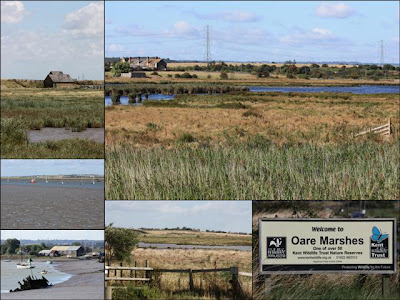To satisfy the curiosity of a number of my readers here are images of the new backpack that was fully loaded in readiness for a day out with Graham yesterday who kindly acted as taxi driver and collected me at 6.45 am.
Our first port of call was Epsom Ponds where we managed to spot a female Mandarin Duck hiding amoungst the waterside vegetation. Also present were Black-headed Gull, Mallard, Grey Heron plus Great Spotted Woodpecker and a Robin were heard.
Graham then drove to the Wey Navigation close to the remains of Newark Priory where we followed the towpath towards Walsham Lock producing more Mallards, Mute Swan, a pair of Kestrels hunting over the water meadow, Lapwing, Jackdaws, Starlings, Woodpigeon, Collared Doves, noisy Parakeets, House Martins, Swallows, Blue and Great Tits. a Great-spotted Woodpecker plus a Goldfinch. We also had an interesting conversation with the local farmer who explained that his cattle loved eating the waterside Himalayan Balsam with apparently no side effects. A few Banded Demoiselles were also resting just above the water.
Further along the towpath this barge owner stirred up the water, much to the annoyance of the fishermen, while attemting to move his craft 'Wendy Woo II' away from its overnight mooring.
We stopped again and chatted to this fisherman who was interested in my camera gear and revealed that he raised butterflies and is releasing Brown Argus at a site very close to where I live. The only flutter we saw was a Speckled Wood plus male Common Blue Damselflies. We crossed over the weir to check around the lock for any Grey Wagtails but there was no sign of them today. While retracing our steps back to the car we picked up the call of a young Common Buzzard and eventually watched it fly to leafless tree but our efforts to get closer for a photo proved unsucessful as it moved further away.
The weather forcast suggested light showers at around 10.00 am so Graham suggested a trip over to Kempton Park Nature Reserve as he has the necessary codes to gain access. This reserve was created in 1995 by Thames Water but I have never visited before so this this would be a new location to explore and it has hides in case the wether turned foul.
As you can see the water levels are very low and much of the old reservoir floor is covered with sphagnum moss. From the first hide we located Mute Swan, Grey Heron, Cormorant, Mallard, Coot, Moorhen, Tufted Duck, Little Grebe, a single Greenshank, several juvenile Pied Wagtails, Sparrowhawk, Black-headed Gulls, Parakeets flying over and Swallows. On our casual stroll to another hide we watched Common Darters, Meadow Browns and Common Blue butterflies. Bottom right image is a very tatty female Common Blue. Blue and Great Tits were also seen at a feeding station.

While eating our packed lunches in the last hide a young Reynard appeared from amoungst the vevetation and sat at the side of the water intently starring in our direction. After an apprehensive look at the water he eventually crossed to the other side and disappeared only to return and swim back while all the resident Mallard and Coots gathered together, totally unfazed by his presence, to watch him get wet again. After a quick shake down he then decided to run back and forth just like a young teenager letting of steam before disappearing back into the leafy undergrowth.
We also had slightly closer views of the Greenshank feeding together with a Common Sandpiper and one of the Grey Herons and a Mute Swan came close enough for the camera. A number of Green Woodpeckers were also spied around the reserve. Another enjoyable day out in good company...thanks Graham. FAB.




























